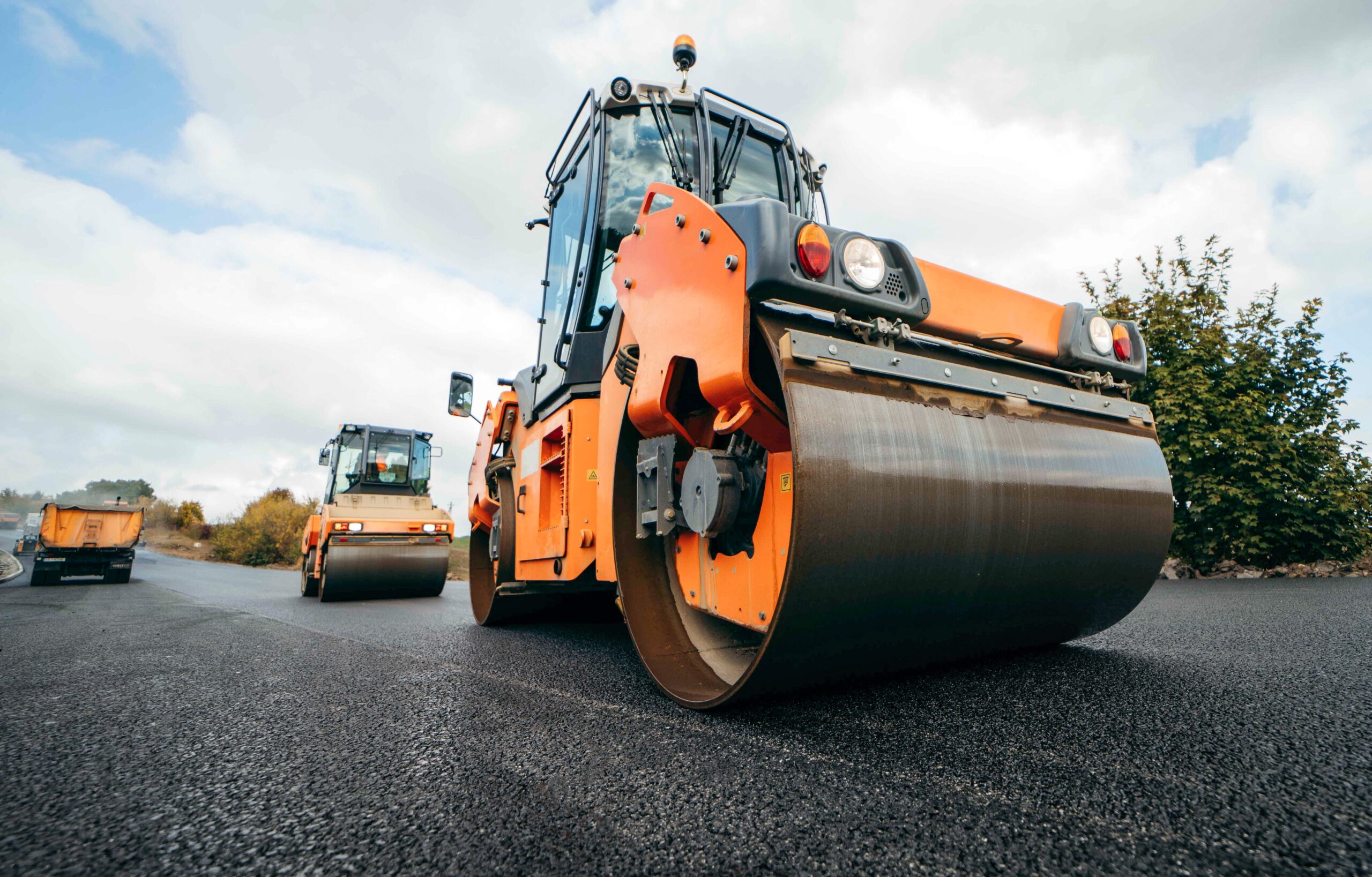Asphalt paving is the paving of asphalt cement, which is further utilized in the production of smooth and durable surfaces. According to the National Asphalt Pavement Association (NAPA), 2.7 million miles of the United States’ roads are surfaced with asphalt; thus, asphalt is the most common paving material in the United States. It is highly used due to its cost-effectiveness, strength, and ductility, and can be applied in various uses.

This guide describes asphalt paving, its types, installation, benefits, and maintenance. It also discusses some of the common issues and what makes asphalt the leading choice for paving. Let’s get started.
Types of Asphalt Paving
Various kinds of asphalt paving serve different purposes in terms of climate, traffic load, environmental demands, and project demands. Each type has certain advantages and applications. For example, during industrial construction, 90 percent of projects employ hot mix asphalt due to its ability to withstand heavy loads and durability.
Here are some types of asphalt paving suitable for both commercial and residential projects.
Hot Mix Asphalt
Hot mix asphalt is manufactured at high temperatures (typically 300-350°F) in order to obtain a proper bond between the aggregates and asphalt cement. It is the most preferred road covering on highways, major roads, and airport runways because of its high strength and ability to support high traffic. According to the U.S. Federal Highway Administration (FHWA), hot mix asphalt surfaces can last up to 20 years with maintenance.
Cold Mix Asphalt
Cold-mix asphalt is mixed at ambient temperatures and thus is appropriate where temporary repairs are necessary, e.g., patching potholes or small driveways. It is economical in short-term maintenance, particularly in areas where hot mix is not feasible due to winter weather conditions.
Warm Mix Asphalt
The warm-mix asphalt is produced at lower temperatures (30-40 degrees Fahrenheit cooler than the hot-mix) and reduces greenhouse gas emissions and energy consumption up to 20 percent. This environmentally sound process allows extension of paving seasons and compaction under cooler temperatures.
Porous Asphalt
Porous asphalt is designed to provide openings through which water flows through the surface, resulting in minimal runoff and reduced recharge of the groundwater. It has been identified by the U.S. Environmental Protection Agency (EPA) as a green infrastructure method of managing stormwater in low-traffic zones and in parking lots.
Recycled Asphalt
Recycled asphalt pavement (RAP) is a way to reuse materials left over after removing old pavement, thereby reducing the need for new aggregate. NAPA states that using engineered asphalt mixes with 30% RAP can perform as well as virgin asphalt mixes while providing significant material cost savings and reducing environmental impact. It is commonly applied in resurfacing roads and driveways.
Applications of Asphalt Paving
There are numerous uses of asphalt in different projects, including
- Roads
- Parking lots
- Driveways
- Runways in airports
- Racetracks
- Bicycle and pedestrian paths
- Industrial yards
Asphalt Paving Installation Process
Proper installation guarantees long-term performance. It involves preparing the site, laying asphalt, compaction, curing, and sealing. For businesses seeking professional-grade results, commercial asphalt paving services are crucial to ensure that every step is executed with precision and expertise. These services guarantee that your pavement will withstand the test of time and traffic, providing reliable performance for years to come.The following are the steps involved in asphalt paving installation.
Step 1: Site Preparation
The space is cleaned, graded, and compacted to provide a stable sub-base. This is the most essential principle in the foundation because inadequate preparation may cause cracks and potholes within a few years.
Step 2: Asphalt Laying and Compaction
Paving machines spread asphalt mix evenly. Rollers compact the material to exclude air gaps and attain uniform density, which strengthens and enhances its durability.
Step 3: Curing and Sealing
The asphalt takes 24 to 48 hours to dry slightly and up to 30 days to harden. After the curing is done, the surface is sealed (sealcoating). This locks the surface against UV, moisture, and oxides to extend the life of the surface by several years.
Benefits of Asphalt Paving
Asphalt paving has a blend of strength, environmental benefits, and cost-effectiveness damage repair that makes it the best option for roads, driveways, and commercial surfaces. In addition to performance, it is one of the most sustainable paving materials out there.
Some of the benefits of asphalt paving are mentioned below:
Durability
Asphalt has the potential to last decades, even in highly trafficked locations such as interstates, with proper maintenance. It is flexible, so it avoids cracking when subjected to heavy loads.
Cost-Effectiveness
Installation of asphalt is approximately 30-40 per cent cheaper than installation of concrete. It is of tremendous value in the long run when coupled with low maintenance.
Smooth Finish and Aesthetic Appeal
Asphalt is a sleek and even surface suitable for roads, driveways, parking lots, and properties, as it adds beauty to a property.
Easy Maintenance
The maintenance of asphalt paving is inexpensive. Furthermore, repairs, such as pothole patching and crack sealing are easy.
Environmental Sustainability
Asphalt is the most recycled product in the United States, and more than 80 million tons of asphalt are recycled annually. Thus, it is beneficial for sustainable urban planning.
Common Asphalt Paving Issues
Even the most durable asphalt will eventually develop issues due to weather, heavy use, and aging. However, with early detection of these problems, you can avoid costly asphalt repairs. Asphalt repair services provide essential solutions to address these issues before they become major problems, helping you extend the life of your asphalt surfaces and maintain their functionality.
Here are some common asphalt paving issues:
Cracking
Cracking is induced by freeze-thaw cycles, overload, or insufficient installation. Early sealing of cracks prevents water infiltration and additional damage.
Potholes
Potholes are formed by the infiltration of water, which freezes and forms ice. Patching or resurfacing can fix potholes.
Poor Drainage
Unnecessary grading can cause poor drainage, which can lead to water pooling. Solutions include grading, drain installation, or porous asphalt.
Surface Deterioration
Oxidation and traffic wear can cause surface deterioration. Sealcoating at intervals of 3 and 5 years prevents premature wear.
Asphalt Paving Maintenance
Regular maintenance keeps asphalt paving in good condition. The following are some tips that you can adapt to maintain asphalt paving.
Crack Sealing
Crack Sealing with sealant prevents moisture intrusion, which is the leading cause of severe damage.
Pothole Repair
The hole is swept and poured with asphalt mix, then packed to last for a long period of time.
Resurfacing and Sealcoating
Resurfacing provides a smooth finish and a protective layer, increasing the lifespan of sealcoating.
Cost of Asphalt Paving
Asphalt paving is affordable and easy to maintain cost-effectively. Following is a breakdown:
Installation Costs
The cost of residential asphalt paving is usually $3 to $5 per square foot, depending on the site’s nature and the type of asphalt.
Long-Term Maintenance Costs
Routine maintenance is also low (typically less than 0.10 per square foot per year) and less expensive than concrete overall.
Durability and Lifespan of Asphalt Paving
An asphalt surface should be expected to last 15 to 20 years when correctly installed, and with proper maintenance, it can last even longer. But congested traffic, extreme weather, and poor drainage are factors that can shorten its life span.
Repairing it at the appropriate time and sealing it regularly will also keep it strong and maintain its appearance. This makes asphalt an inexpensive long-term option for many property owners.
New Asphalt Construction
The following steps are required for a new asphalt construction:
Step 1: Project Planning
Project planning is essential for new asphalt construction. It incorporates design, permits, and traffic load.
Step 2: Material Selection
The correct asphalt type will guarantee performance based on the provided climate and usage. Selecting the right material for asphalt paving is crucial.
Step 3: Site Preparation and Excavation
Digging, compacting, and grading provide a firm foundation to provide permanent results.
Equipment Used in Asphalt Paving
Specialized equipment is used in professional asphalt paving, which makes it smooth and even. Pavers lay the asphalt evenly, rollers compact it to make it durable, and trucks dump the hot mix. Compactors are also employed in more compact spaces and sides where rollers do not penetrate. The proper tools guarantee quality work and minimize early destruction.
Environmental Impact of Asphalt Paving
Asphalt is the most recycled product worldwide, and therefore, it is considered environmentally friendly when it is used as a paving material. Emissions during the manufacturing process are reduced by the use of Reclaimed Asphalt Pavement (RAP) and warm mix asphalt. Recycling the old asphalt helps to save natural resources and reduce waste.
Choosing an Asphalt Paving Contractor
The most important part of getting a rugged and beautiful asphalt surface is selecting a suitable contractor. Find experienced and registered contractors who have a track record of successful projects of this nature. You can determine their reliability by reading customer reviews and requesting references. A good contractor will also give a clear and detailed estimate in advance.
Why Asphalt Paving is the Best Choice?
Asphalt is the most cost-effective, long-lasting, and environmentally sound paving option. Its smooth surface increases safety, reduces vehicle wear, and is pleasing to the eye as well. It is a very lasting solution, but only as long as it is installed and maintained correctly.
With an experienced contractor, you can be confident that the full benefit of this versatile paving solution will be derived. The Asphalt Coatings Company has more than 40 years of experience in asphalt paving, sealcoating, and maintenance for property owners. Call us now to get a free quote and learn how we will ensure that your pavement is always in the best shape year-round.
FAQs
Is asphalt paving durable?
Yes. Properly installed and maintained asphalt can last 15-20 years or more before it wears away due to weather and traffic.
Can asphalt paving withstand heavy traffic?
Absolutely. Asphalt can bear heavy weight, making it suitable for use in highways, industrial zones, and crowded commercial parking lots.
Is asphalt paving cost-effective?
Yes. The costs of installing asphalt are usually lower than those of concrete, and the costs of maintenance over its lifespan are minimal.
Is porous asphalt environmentally friendly?
Yes. Porous asphalt can enhance stormwater management by allowing water to drain through it, thereby decreasing runoff and promoting environmentally friendly construction.
Does asphalt require maintenance?
Yes. Regular sealing, crack filling, and repairs can significantly prolong the life and efficiency of an asphalt surface.




